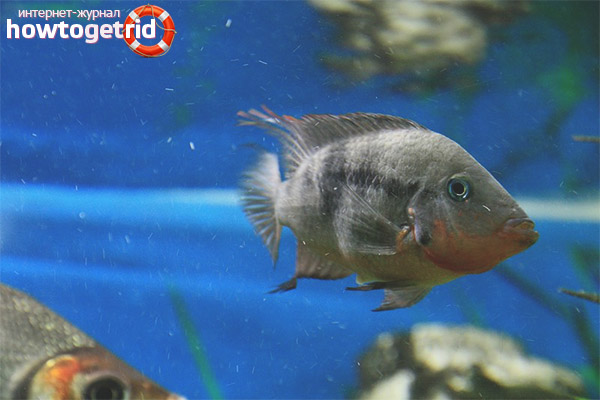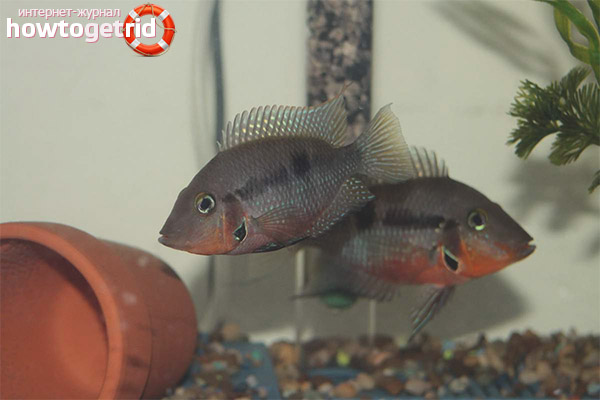The content of the article
Meek's cichlazoma has the Latin name Thorichthys meeki, and is one of the most popular representatives of cichlids. These fish are in great demand due to many advantages. They have an attractive appearance - the color of the fish is bright red. In addition, they get along well with other fish. Representatives of this species are not very demanding in care.
If we compare them with other cichlids that came from Central America, the fish are small. In length, they grow up to 17 cm. Their composition is graceful and slender. You can buy such a fish not only for an experienced aquarist, but also for a beginner. As already mentioned, due to the unpretentiousness of Mekek’s Cichlazoma, it is quite simple to take care of her. In addition, it does not pose a danger to other individuals, and can get along with them in another aquarium. But it is still desirable to settle representatives of this species with the same large fish or separately from everyone. In normal times, they do not show any aggression towards neighbors in the aquarium, but it may well develop suddenly during spawning. Meek's cichlazoma drives other individuals out of the territory, especially small ones.
During spawning, the male of this species changes its appearance. He is becoming very beautiful. The throat acquires a red tint, and the body of the fish darkens. This usually scares away the rest of the males, but rather attracts the female.
Living in nature
Representatives of the species of Ciechlazome Meek are inhabitants of rivers or canals with slow-flowing waters. They live near the bottom or in the middle layer. In addition, they can be found in ponds. In reservoirs where meeks live, usually sandy or silty soil. They feed on both plant and animal food. In reservoirs try to be near overgrown sites.
Description
Representatives of the species have a graceful body. Their muzzle is pointed. The fins of the fish are large, have pointed ends. In nature, representatives of the species of the Mech Cichlazoma can grow up to 17 cm. With an aquarium content, they usually grow to smaller sizes. The average length in males can reach about 12 cm. In this case, females are usually 2 cm less. Such a fish can live 10-12 years.
The main feature of the appearance is the red color of the throat and gills. Part of the abdomen is also colored red. The rest of the body has a steel color. It has vertically arranged dark spots. Fish that live in different areas may vary slightly in color.
Content Issues
You can even buy such a fish even for those who have practically no experience in maintaining the aquarium, because Meyek’s Tsikhlazoma is unpretentious. It can adapt to various conditions. This is due to the fact that fish of this species live in a variety of waters, and have learned to adapt in order to survive. But when caring for these fish, you still need to follow the basic rules.
Another advantage is the omnivore of these fish. Almost any food is suitable for them. In addition, with other inhabitants of the aquarium, she gets along quite peacefully.
Feeding
Meek's cichlazoma can eat any kind of food. They are suitable for living, and artificial, and frozen. To maintain the health of these fish in good condition, it is desirable that their food be varied. Therefore, they should be given alternately each of the species that were listed above. The main diet may be special feed for cichlids. They should be of the highest quality. They contain the necessary components to keep Meek’s cichlazoma healthy. Supplementing the diet can serve as live food. But bloodworms should be given only occasionally so as not to provoke inflammation of the digestive tract.
Content
If you plan to keep only a couple of these fish, an aquarium of 150 liters is enough. If there will be more, you need to purchase a minimum of two hundred liter aquarium. Representatives of this species, like other cichlids, need very clean water. The course should be moderate. It is created by an external filter. In addition, water should be changed periodically.
Mekek's cichlazoma loves to delve into the ground. Therefore, sand is recommended for these purposes. It will be convenient for a fish to build a nest in it. When arranging an aquarium for meek, experts advise installing more decor, which the fish could use as a shelter. It can be pots, caves, pebbles, etc., because meeks love to hide in them.
If you want to plant plants in the aquarium, it is best to plant them there in pots. Otherwise, the fish can dig them up. From plants should choose large and hard. For example, echinodorus and anubias.
Representatives of the species, although unpretentious to the characteristics of the water, will still feel better at 24-26 degrees. If you comply with the conditions of detention, the fish will live for a long time.
Compatibility
Meek's cichlazoma can coexist with other fish. It is desirable that these were the same large individuals. Aggression of fish of this species is shown only during the spawning period. Those individuals who violate their territory at this time may be prosecuted. Sometimes Ceylazoma Meeka kills neighbors whom she considers dangerous. If you are worried about the safety of individuals adjacent to this cichlid during spawning, it is best to plant them temporarily. Meek’s cichlazoma can live with scalars and Akars. But the astronotus is too big and aggressive a neighbor for her.
During spawning, these fish can dig a lot in the ground and carry parts of it from place to place. Therefore, it is important to monitor the plants planted in the aquarium, or plant them in pots.
Representatives of this species form an established pair, and also take good care of their offspring. In one aquarium several pairs of such fish can coexist, but the volume should be large. At the same time, each fish should have its own place in order to take refuge.
Gender differences
Breeding
The most difficult moment in the reproduction of representatives of this species in the aquarium is the formation of a pair. They are monogamous. Therefore, in order to breed them, you need to either buy an already established pair, or raise a few young ones so that they can decide for themselves.
The pair cleans the stone, and then the female lays eggs. At one time, Mekek's Cichlazoma lays up to 500 eggs. When fry hatch, parents take care of them. Fry hiding in shelters, and fish protect them until they grow up. After a week, they begin to swim.
Video: aquarium fish cichloma meek












Submit